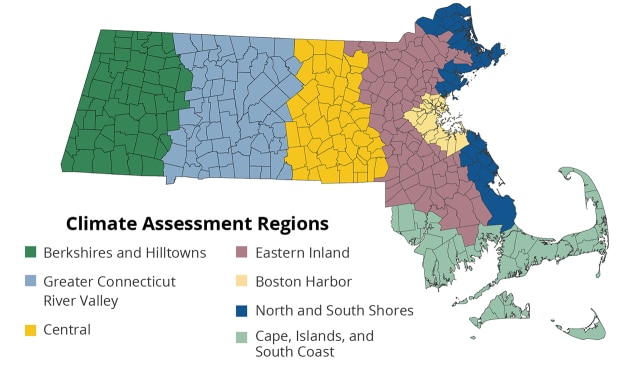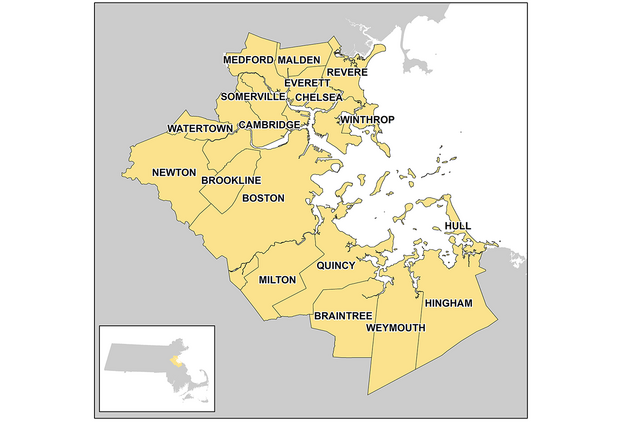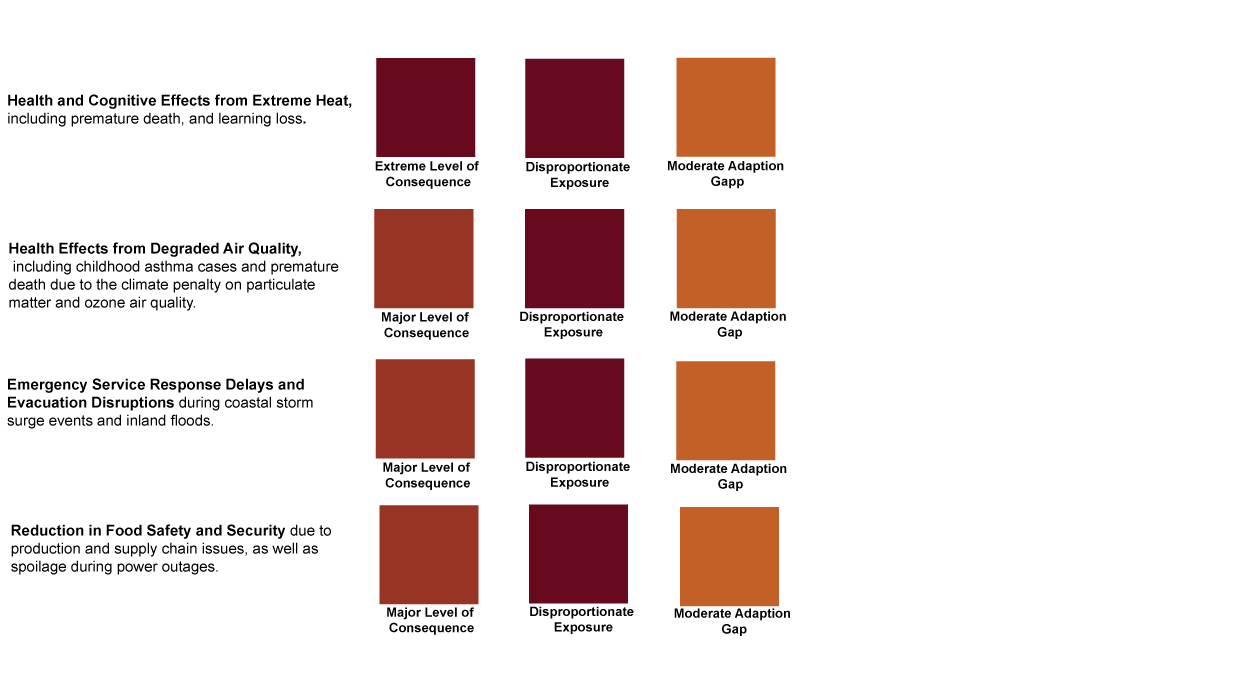Overview
The Commonwealth is already experiencing climate change impacts. Region-specific priorities reflect the unique hazards, natural and built environments, and demographics of each part of the Commonwealth. The Climate Assessment evaluated risks across seven regions:
- Berkshires and Hilltowns Region
- Greater Connecticut River Valley Region
- Central Region
- Eastern Inland Region
- Boston Harbor Region
- North and South Shores Region
- Cape, Islands, and South Coast Region
Volume III of the Climate Assessment includes a summary and full report on each region.
Share These Findings
Share findings about the Boston Harbor region from the MA Climate Change Assessment with your community through the example social media content below:
Regional Context
The Boston Harbor region encompasses the Commonwealth’s largest urban center. Despite being the smallest region by area, Boston Harbor is the second most populous and includes more than a third of the state’s environmental justice block groups as designated by EEA. The region is a key economic hub, featuring expanding employment opportunities, an increasingly competitive housing market, and the state’s largest port. Healthcare and professional and technical services are fast-growing industries in the region, with construction, manufacturing, and other service industries also playing key roles. This economic activity is supported by a dense network of transportation, communication, and energy infrastructure.
While Boston Harbor is primarily characterized by these urban features, the region’s 18 cities and towns are also home to key natural resources. Nearly 2,000 acres of high marsh provide valuable ecosystem services, including coastal protection. The region’s beaches, parks, and other green spaces provide recreational opportunities and much-needed stormwater infiltration capacity.
The Boston Harbor region boundary used for this assessment encompasses the Office of Coastal Zone Management’s Boston Harbor region and overlaps with small segments of the North Shore and South Shore regions. The boundary includes the coastal areas of the Municipal Vulnerability Preparedness (MVP) program’s Greater Boston region. Climate adaptation is a strong focus, with all 18 cities and towns engaged in climate vulnerability and resilience planning through the MVP program.
The most important climate hazards for the region include temperature extremes and changes to coastal hazards, including coastal flooding and the potential for hurricane force winds. Temperature changes affect air quality, human health, and road and rail infrastructure. Coastal hazards can affect built infrastructure, rapid transit and mobility overall, emergency service response times, and the incidence of injuries and death.
Most Urgent Impacts - Human Sector
With more than 1.6 million residents, the Boston Harbor region is projected to experience some of the most significant Human sector impacts in the state. Health and Cognitive Effects from Extreme Heat is the most urgent impact in the region. Projected increases in the frequency of extreme heat events coupled with the region’s high population density produce rates of temperature-related premature mortality that are 30 to 50 percent higher than the statewide average. Other outcomes of extreme heat including learning loss in schools, increased emergency department visits, and occupational injuries. Efforts to adapt to heat effects in the region are ahead of most other parts of the state, but given the significant potential effects, further coordination is needed.
One of the largest food distribution centers in Massachusetts is located in Everett and sits the 100-year floodplain of the Mystic River, where it may be vulnerable to flooding, potentially interrupting food supply chains (Reduction in Food Safety and Security). The region’s coastal location, high population density, and high proportion of residents reliant on public transportation pose challenges for evacuations and emergency response (Emergency Service Response Delays and Evacuation Disruptions). Increased ozone and particulate matter concentrations from climate change are projected to cause 430 additional childhood asthma diagnoses and more than 70 premature deaths among the population aged 65-plus annually by 2090 (Health Effects from Degraded Air Quality).
*Due to tied scores in the urgency rankings, the Human sector has four most urgent impacts for this region.
Read more about human sector impacts in the report.
Most Urgent Impacts - Infrastructure Sector
Damage to Rails and Loss of Rail/Transit Service is the most urgent Infrastructure sector impact in the region. For the Boston Harbor portion of commuter and freight rail lines, rail repair costs in response to extreme heat deforming rails are the second largest among regions in the state, behind only the Eastern Inland region. A recent study investigated measures of system resilience for the MBTA’s rail rapid transit system and found that the combined effects of sea level rise and increased coastal storm frequency could render significant portions of the network inoperable, with projected interruptions becoming more widespread and severe later in the century.
Loss of Urban Tree Cover is another significant and disproportionately distributed impact in the Boston Harbor region. Climate change is projected to stress urban trees through increased extreme event frequency, increased threat from pests, and reduced water and soil quality, leading to more frequent tree mortality and higher management costs. Projected temperature increases and the urban heat island effect make tree coverage particularly valuable in a large urban center like the Boston metro area, which also features a high density of EJ block groups.
Read more about infrastructure sector impacts in the report.
Most Urgent Impacts - Natural Environment Sector
While Boston Harbor is largely urban, nearby natural resources play a significant cultural and economic role in the region. Projected climate changes represent a significant departure from existing conditions and have the potential to exacerbate coastal storm impacts and cause systemic disruptions to the region’s ecosystems. Increases in sea surface temperature can alter weather patterns and storm tracks and force marine species beyond their historic range in search of suitable habitat. Ocean acidification related to increasing CO2 concentrations further threatens marine habitats and species. Freshwater ecosystems are at risk from increased nutrient loading and harmful algal bloom growth, increased contaminant concentrations during drought conditions, and shifting habitat regimes as air and water temperatures rise. Adaptation around the threats to both marine and freshwater ecosystems is lagging compared with the action needed to respond to these challenges.
Read more about natural environment sector impacts in the report.
Most Urgent Impacts - Governance Sector
Boston Harbor’s most urgent Governance sector impacts are Increase in Demand for State and Municipal Government Services and Reduction in State and Municipal Revenues. Climate change effects across a range of other impacts could increase reliance on government services, driving up expenses. This could include increased needs for MassHealth, food security support, and emergency response as a result of climate change. Similarly, long-term climate impacts on municipal tax bases, are a potentially significant risk that is not well characterized in the available literature. Many of these impacts can be expected to be concentrated among those residing in EJ-designated block groups.
Most Urgent Impacts - Economy Sector
The current need for affordably priced housing is acute in the Boston Harbor region, which has the most expensive housing costs in the Commonwealth. This region is home to a large number of federally subsidized affordable housing units vulnerable to coastal flood risk These coastal flood threats and higher construction costs needed to increase building resilience may limit the availability of affordably priced housing.
Similar challenges from flooding and storm damage exist for businesses in the Boston Harbor region, which is home to the largest economic hub in the Commonwealth. Business closures and direct damages to commercial structures are of particular concern for the region, which accounts for approximately 89 percent of the estimated annual statewide direct damages to the commercial and industrial properties in projections through the end of the century.
Featured Adaptation Effort
Heat Resilience Solutions for Boston
The City of Boston developed a comprehensive heat preparedness plan and implementation roadmap outlining a wide variety of strategies for addressing extreme heat, ranging from pop-up cooling stations to proposed zoning revisions to support cooler neighborhoods.
Quick links
- ResilientMass Homepage
- ResilientMass Site Map
- Massachusetts Climate Change Assessment
- Massachusetts Climate Change Assessment – Berkshires and Hilltowns Region
- Massachusetts Climate Change Assessment – Greater Connecticut River Valley Region
- Massachusetts Climate Change Assessment – Central Region
- Massachusetts Climate Change Assessment – Eastern Inland Region
- Massachusetts Climate Change Assessment – North and South Shores Region
- Massachusetts Climate Change Assessment – Cape, Islands, and South Coast Region
- Massachusetts Climate Change Assessment – Regional Summary Volume III
- Massachusetts Climate Change Assessment – Regional Report Volume III










